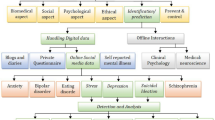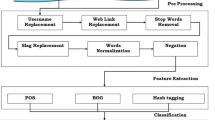Abstract
Urban sentiment, as people’ perception of city environment and events, is a direct indicator of the quality of life of residents and the unique identity of a city. Social media by which people express opinions directly provides a way to measure urban sentiment. However, it is challenging to depict collective sentiments when integrating the posts inside a particular place, because the sentiment polarities will eventually be neutralized and consequently result in misinterpretation. It is necessary to capture positive and negative emotions distinguishingly rather than integrating them indiscriminately. Following the psychological hypothesis that two polar emotions are processed in parallel and can coexist independently, a novel dual-polarity metric is proposed in this paper to simultaneously evaluate collective positive and negative sentiments in geotagged social media in a place. This new measurement overcomes the integration problem in traditional methods, and therefore can better capture collective urban sentiments and diverse perceptions of places. In a case study of Beijing, China, urban sentiments are extracted using this approach from massive geotagged posts on Sina Weibo, a Twitter-like social media platform in China, and then their spatial distribution and temporal rhythm are revealed. Positive sentiments are more spatially heterogeneous than negative sentiments. Positive sentiments are concentrated in scenic spots, commercial and cultural areas, while negative sentiments are mostly around transportation hubs, hospitals and colleges. Following the principle of sense of place, multi-source data are integrated to evaluate the effects of influencing factors. The variation of spatial factors aggravates the heterogeneity of urban sentiment. The discovered spatiotemporal patterns give an insight into the urban sentiment through online behaviors and can help to improve city functionality and sustainability.








Similar content being viewed by others
References
Aman JJC, Smith-Colin J, Zhang W (2021) Listen to E-scooter riders: Mining rider satisfaction factors from app store reviews. Transp Res Part D Transp Environ 95:102856
Ballas D, Tranmer M (2012) Happy people or happy places? A multilevel modeling approach to the analysis of happiness and well-being. Int Reg Sci Rev 35:70–102
Batty M (2013) The new science of cities. The MIT Press, London
Beidler KJ, Morrison JM (2015) Sense of place: inquiry and application. J Urban Int Res Placemak Urban Sustain 9(3):205–215
Bollen J, Mao H, Zeng X (2011) Twitter mood predicts the stock market. J Comput Sci 2(1):1–8
Cao X, MacNaughton P, Deng Z, Yin J, Zhang X, Allen JG (2018) Using twitter to better understand the spatiotemporal patterns of public sentiment: a case study in Massachusetts, USA. Int J Environ Res Public Health 15(2):250–264
Carruthers J, Mulligan G (2012) The plane of living and the precrisis evolution of housing values in the USA. J Econ Geogr 12(4):739–773
Clark LA, Watson D (1988) Mood and the mundane: relations between daily life events and self-reported mood. J Pers Soc Psychol 54(2):296–308
Davidson J, Bondi L (2004) Spatialising affect; affecting space: an introduction. Gend Place Cult 11(3):373–374
Diener E, Emmons RA (1984) The independence of positive and negative affect. J Pers Soc Psychol 47(5):1105–1117
Diener E, Suh E (1997) Measuring quality of life: economic, social and subjective indicators. Soc Indic Res 40:189–216
Dodds PS, Harris KD, Kloumann IM, Bliss CA, Danforth CM (2011) Temporal patterns of happiness and information in a global social network: Hedonometrics and Twitter. PLoS ONE 6(12):e26752
Frank MR, Mitchell L, Dodds PS, Danforth CM (2013) Happiness and the patterns of life: a study of geolocated tweets. Sci Rep 3:2625
Getis A, Ord JK (1992) The analysis of spatial association by use of distance statistics. Geogr Anal 24(3):189–206
Ghahramani M, Galle NJ, Ratti C, Pilla F (2021) Tales of a city: sentiment analysis of urban green space in Dublin. Cities 119:103395
Golder SA, Macy MW (2011) Diurnal and seasonal mood vary with work, sleep, and daylength across diverse cultures. Science 333(6051):1878–1881
Gong VX, Daamen W, Bozzon A, Hoogendoorn SP (2019) Estimate sentiment of crowds from social media during city events. Transp Res Rec 2673(11):836–850
Hosseinzadeh A, Algomaiah M, Kluger R, Li Z (2021) Spatial analysis of shared e-scooter trips. J Transp Geogr 92:103016
Hu Y, Deng C, Zhou Z (2019) A semantic and sentiment analysis on online neighborhood reviews for understanding the perceptions of people toward their living environments. Ann Am Assoc Geogr 109(4):1052–1073
Huang Z, Qi H, Kang C, Su Y, Liu Y (2020) An ensemble learning approach for urban land use mapping based on remote sensing imagery and social sensing data. Remote Sens 12(19):3254
Jabreel M, Moreno A, Assumpció H (2017) Semantic comparison of the emotional values communicated by destinations and tourists on social media. J Destin Mark Manag 3:163–276
Jackson JB (1995) A sense of place, a sense of time. Des Q 8(164):24–27
Kovacs-Gyori A, Ristea A, Havas C, Resch B, Cabrera-Barona P (2018a) #London2012: towards citizen-contributed urban planning through sentiment analysis of twitter data. Urban Plan 3(1):75–99
Kovacs-Gyori A, Ristea A, Kolcsar R, Resch B, Crivellari A, Blaschke T (2018b) Beyond spatial proximity—classifying parks and their visitors in London based on spatiotemporal and sentiment analysis of Twitter data. ISPRS Int J Geo Inf 7(9):378–403
Lewis PF (1979) Defining a sense of place. South Q 17(3 & 4):24–46
Liu B (2012) Sentiment analysis and opinion mining. Synth Lect Hum Lang Technol 5(1):1–167
Liu Y, Yuan Y, Zhang F (2020) Mining urban perceptions from social media data. J Spat Inf Sci 20:51–55
Mitchell L, Frank MR, Harris KD, Dodds PS, Danforth CM (2013) The geography of happiness: connecting Twitter sentiment and expression, demographics, and objective characteristics of place. PLoS ONE 8(5):e64417
O'Connor B, Balasubramanyan R, Routledge BR, Smith NA (2010) From tweets to polls: linking text sentiment to public opinion time series. In: Proceedings of the fourth international conference on weblogs and Social Media, ICWSM 2010, Washington, DC, USA, May 23–26
Ord JK, Getis A (1995) Local spatial autocorrelation statistics: distributional issues and an application. Geogr Anal 27(4):286–306
Padilla JJ, Kavak H, Lynch CJ, Gore RJ, Diallo SY (2018) Temporal and spatiotemporal investigation of tourist attraction visit sentiment on Twitter. PLoS ONE 13(6):e0198857
Pang B, Lee L (2008) Opinion mining and sentiment analysis. Found Trends Inf Retr 2(1–2):1–135
Plunz RA, Zhou Y, Vintimilla MIC, Mckeown K, Yu T, Uguccioni L, Sutto MP (2019) Twitter sentiment in New York City parks as measure of well-being. Landsc Urban Plan 189:235–246
Proshansky HM, Fabian AK, Kaminoff R (1983) Place-identity: physical world socialization of the self. J Environ Psychol 3(1):57–83
Quercia D, Schifanella R, Aiello LM (2014) The shortest path to happiness: recommending beautiful, quiet, and happy routes in the city. In: Proceedings of the 25th ACM conference on hypertext and social Media, Santiago, Chile, September 1–4
Raul B, Peter T, Stephen K (2015) Eliciting mixed emotions: a meta-analysis comparing models, types, and measures. Front Psychol 6:428
Relph E (1976) Place and placelessness. Pion, London
Resch B, Summa A, Zeile P, Strube M (2016) Citizen-centric urban planning through extracting emotion information from Twitter in an interdisciplinary space-time-linguistics algorithm. Urban Plan 1(2):114–127
Seresinhe CI, Preis T, MacKerron G, Moat HS (2019) Happiness is greater in more scenic locations. Sci Rep 9:4498
Tan MJ, Guan C (2021) Are people happier in locations of high property value? Spatial temporal analytics of activity frequency, public sentiment and housing price using twitter data. Appl Geogr 132:102474
Vapnik V (1995) The nature of statistical learning theory. Springer, New York
Wang Z, Zhu Z, Xu M, Qureshi S (2021) Fine-grained assessment of greenspace satisfaction at regional scale using content analysis of social media and machine learning. Sci Total Environ 776:145908
Wilkinson R, Pickett K (2010) The spirit level: why equality is better for everyone. Penguin, London
Yang W, Mu L, Shen Y (2015) Effect of climate and seasonality on depressed mood among twitter users. Appl Geogr 63:184–191
Yao Y, Li X, Liu X, Liu P, Liang Z, Zhang J, Mai K (2017) Sensing spatial distribution of urban land use by integrating points-of-interest and Google Word2Vec model. Int J Geogr Inf Sci 31(4):825–848
Ye C, Zhang F, Mu L, Gao Y, Liu Y (2021) Urban function recognition by integrating social media and street-level imagery. Environ Plan B: Urban Anal City Sci 48(6):1430–1444
Yuan Y, Wei G, Lu Y (2018) Evaluating gender representativeness of location-based social media: a case study of Weibo. Ann GIS 24(3):163–176
Yuan Y, Lu Y, Chow TE, Ye C, Alyaqout A, Liu Y (2020) The missing parts from social media-enabled smart cities: who, where, when, and what? Ann Am Assoc Geogr 110(2):462–475
Zhang F, Zhou B, Liu L, Liu Y, Fung HH, Lin H, Ratti C (2018) Measuring human perceptions of a large-scale urban region using machine learning. Landsc Urban Plan 180(8):148–160
Zhang F, Zu J, Hu M, Zhu D, Kang Y, Gao S, Zhang Y, Huang Z (2020) Uncovering inconspicuous places using social media check-ins and street view images. Comput Environ Urban Syst 81(2):101478
Zheng S, Wang J, Sun C, Zhang X, Kahn M (2019) Air pollution lowers Chinese urbanites’ expressed happiness on social media. Nat Hum Behav 3:237–243
Funding
This research was supported by the National Natural Science Foundation of China (Grant Numbers 41971331, 41830645) and Smart Guangzhou Spatio-temporal Information Cloud Platform Construction (GZIT2016-A5-147).
Author information
Authors and Affiliations
Corresponding author
Ethics declarations
Conflicts of interest
There are no conflicts of interest.
Availability of data and material
Not applicable.
Code availability
Not applicable.
Additional information
Publisher's Note
Springer Nature remains neutral with regard to jurisdictional claims in published maps and institutional affiliations.
Rights and permissions
About this article
Cite this article
Gao, Y., Chen, Y., Mu, L. et al. Measuring urban sentiments from social media data: a dual-polarity metric approach. J Geogr Syst 24, 199–221 (2022). https://doi.org/10.1007/s10109-021-00369-z
Received:
Accepted:
Published:
Issue Date:
DOI: https://doi.org/10.1007/s10109-021-00369-z




